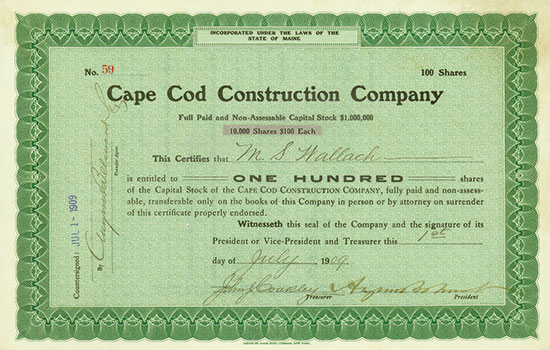Ingelsberg 17 b
D- 85604 Zorneding
Deutschland / Germany
Tel.: +49 (0)8106 - 2461-86
Fax: +49 (0)8106 - 2461-88
E-Mail: auktion@hwph.de
HWPH Historisches Wertpapierhaus AG –
Váš specialista na historické cenné papíry
a historii finančnictví
|
||||
Číslo |
2219 | |||
Titul |
Cape Cod Construction Company | |||
Místo(a) |
||||
Země |
USA | |||
Region |
Amerika | |||
Popis |
State of Maine, 01.07.1909, 100 Shares of Capital Stock, #59, 17,7 x 27,5 cm, grün, schwarz, Original-Signatur August Belmont. Das Stück stammt aus dem Lehman Erbe! | |||
Popis (Angličtina) |
State of Maine, 1 July 1909, 100 Shares of Capital Stock, #59, 17.7 x 27.5 cm, green, black, signed by August Belmont. The item was part of the Lehman Brothers archive! | |||
Stav |
EF | |||
 |
||||
Historie (Německo) |
Cape Cod ist eine nach den in ihrer Umgebung ehemals großen Kabeljau-Vorkommen benannte Halbinsel im östlichsten Teil von Massachusetts. Sie bot einen der größten und sichersten Naturhäfen Neuenglands, durch den bereits im 17. Jahrhundert zahlreiche Pilgerväter an Land gehen konnten. Bereits zu dieser Zeit erkannte man zudem die Vorteile, die eine Trennung der Halbinsel mittels eines Kanals und ein dadurch stark vereinfachter Weg Richtung Long Island Sound sowie nach New York für den Handel mit sich bringen würde. Doch erst, als George Washington während des amerikanischen Unabhängigkeitskrieges die militärische Bedeutung in Form einer besseren Unterstützung der Marine herausstellte, begann man mit ernsthafteren Untersuchungen und Planungen. An dem Projekt versuchten sich im Laufe des 19. Jahrhunderts sodann zahlreiche Gruppierungen und Gesellschaften, die letztlich alle etwas gemeinsam hatten: Sie gingen pleite, ehe es nennenswerte Fortschritte gab. Da jedoch an der heimtückischen Küste entlang der Halbinsel immer mehr Schiffe verunglückten (Ende der 1880er Jahre ca. alle zwei Wochen eines!), wurde der Plan nicht fallen gelassen. Eine bereits 1899 gegründete Boston, Cape Cod and New York Canal Company wurde daher im Jahr 1904 vom reichen Finanzier August Perry Belmont übernommen und umstrukturiert. Als Chefingenieur engagierte er William Barclay Parsons, der sowohl aus dem Eisenbahnbereich (z. B. der Instandhaltungsabteilung der New York, Lake Eries and Western Railroad) als auch aus seiner Mitarbeit beim Bau des Panamakanals einige Erfahrung mitbrachte. 1909 begann man mit dem Bau, der trotz aller Kompetenz mit der Zeit alles andere als einfach bleiben sollte: Parsons unterschätze die Existenz sogenannter Mammutfelsen, welchen man nur mit großen Mengen an Dynamit begegnen konnte, das meist von Tauchern mühsam unter Wasser platziert werden musste. Zudem erforderten die großen Mengen an Gestein zum Abtransport den temporären Einsatz von Schmalspurbahnen. 1912 orderte Belmont von der American Locomotive Company zusätzlich 2 große Schwimmbagger, um die Arbeiten endlich zum Abschluss bringen zu können - was 1914 schließlich gelang. In den folgenden 25 Jahren wurde der Kanal erneut verbreitert bzw. in der Tiefe ausgebaggert - ferner mussten zahlreiche Brücken neu gebaut werden, um größeren Schiffen die Durchfahrt zu ermöglichen. Nachdem die Arbeiten 1940 abgeschlossen waren, war der Kanal weltweit der größte auf Meereshöhe. | |||
Historie (Angličtina) |
Cape Cod, a peninsula in the easternmost portion of Massachusetts, provided one of the largest and safest natural harbours of New England, being used by many Pilgrim Fathers to go ashore in the 17th century. Since then the advantages of a direct route to Long Island Sound and New York for trading are well known. During the American Revolutionary War George Washington further realized the importance of a canal for a better support of the American fleet while fighting against its enemies. Over the 19th century numerous surveys and plans were made by various groups and companies, finally having in common that they all ran out of money before making noteworthy progress. In the meantime the number of shipwrecks along the treacherous coast of Cape Cod continued to increase to about one every two weeks in the late 1880s. Therefore the wealthy financier August Perry Belmont took over the 1899 founded Boston, Cape Cod and New York Canal Company in 1904. After reorganizing the company he engaged William Barclay Parsons as Chief Engineer. Parsons, having a lot of experience from his work in the maintenance of way department of the New York, Lake Eries and Western Railroad and his appointment to the Isthmian Canal Commission for the construction of the Panama Canal, started to work in 1909. Being on schedule for some time the group had to realize that Parsons had underestimated the presence of glacial boulders along the route. The increased demand of dynamite, which had mostly to be placed by divers, slowed down the work significantly. Falling behind schedule the Canal Company decided to use narrow gauge railroad tracks to carry material off, further Belmont ordered two large dipper dredges from American Locomotive Company in 1912. In April 1914 the Canal was finally opened as a privately operated toll waterway. Within the following 25 years it became wider and deeper, further several bridges had to be rebuilt to enable a passage for larger ships. In 1940 the Cape Cod Canal was the widest sea level Canal in the world. | |||
Povšimněte si prosím také nejlepších položek naší aukce: |
||||













